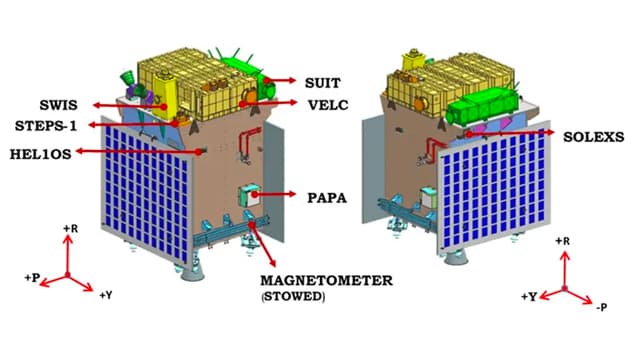With the impending launch of India’s inaugural solar mission, the Indian Space Research Organisation or ISRO provided an update on the mission’s status. On August 30, ISRO announced the successful completion of the launch rehearsal and internal assessments of the rocket.
The Aditya-L1 spacecraft has been purposefully crafted to allow Indian astrophysicists to remotely examine the Sun, and everything that it entails. This includes some really critical areas such as coronal heating, coronal mass ejections, pre-flare and flare activities, along with their distinct characteristics.
Additionally, these investigations will enhance our understanding of space weather dynamics and the behaviour of particles and fields as they propagate through space.

To that effect, the Aditya-L1 solar observatory is carrying the following equipment as payload:
Visible Emission Line Coronagraph(VELC)
The Visible Emission Line Coronagraph (VELC) payload is a remote sensing payload and will study the solar corona and dynamics of Coronal Mass Ejections. This is the main payload of the observatory and will be taking about 1,440 super high-resolution photos of the Sun every day, and relay everything back to ISRO’s ground station.
Solar Ultraviolet Imaging Telescope (SUIT)
The Solar Ultraviolet Imaging Telescope or SUIT payload will take images of the Solar Photosphere and Chromosphere in near Ultra-violet (UV) and also measure the solar irradiance variations in near UV. The SUIT is also a remote-sensing payload.
Solar Low Energy X-ray Spectrometer (SoLEXS) and High Energy L1 Orbiting X-ray Spectrometer(HEL1OS)
The two other remote-sensing payloads onboard the Aditya-L1 observatory will be the Solar Low Energy X-ray Spectrometer or SoLEXS, and the High Energy L1 Orbiting X-ray Spectrometer(HEL1OS). Both of these payloads will work together, or in tandem and take multiple photos of the X-ray flares from the Sun over a wide energy range. That way, they will be able to see flares and reactions that would be normally invisible to humans.
Aditya Solar Wind Particle Experiment(ASPEX) and Plasma Analyser Package For Aditya (PAPA)
Both of these payloads are in-situ payloads, meaning they will be analysing the data that the observatory’s sensors collect on their own, without any intervention from the ground team. Usually, in-situ payloads or instruments have a very specific objective, and analyse data for very specific study.
Both the payloads will study solar wind and energetic ions, as well as their energy distribution. ASPEX will study protons and other heavier particles, whereas PAPA will study electrons and other particles.
Advanced Tri-axial High-Resolution Digital Magnetometers
These are an array of magnetometers that will take readings and analyse interplanetary magnetic fields around the Lagrange Point L1. Like ASPEX and PAPA, this one is also an in-situ payload.
The mission itself is set to be launched on September 2 at 11:50 AM from the Sriharikota spaceport. ISRO conveyed in a recent social media post that the launch preparations are steadily advancing, emphasizing that both the launch rehearsal and vehicle internal checks have been successfully concluded.

0 Comments: